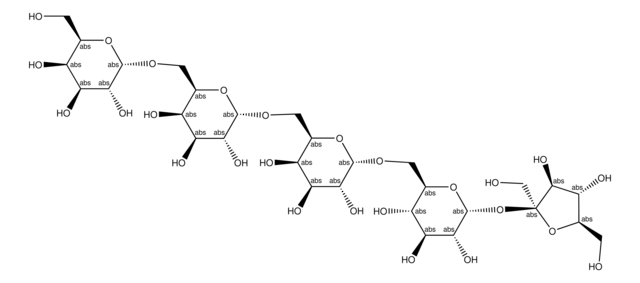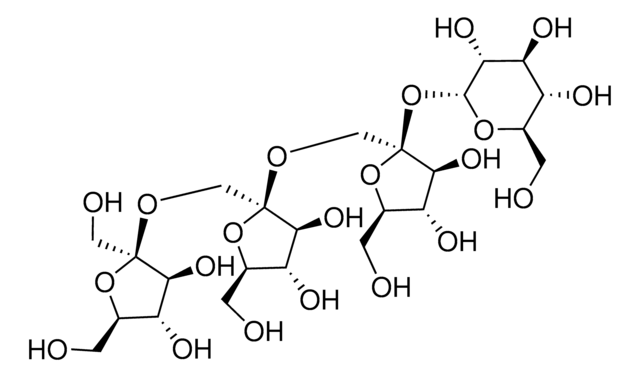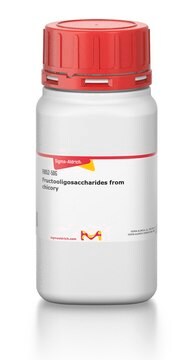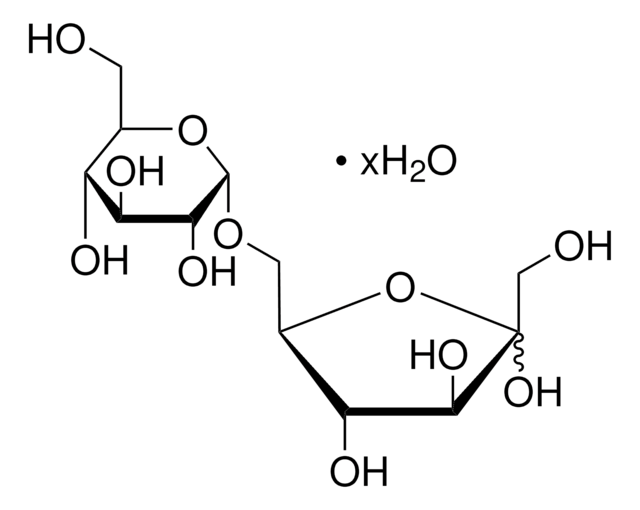S4001
Stachyose hydrate
≥98% (HPLC)
Sinónimos:
α-D-Gal-(1→6)-α-D-Gal-(1→6)-α-D-Glc-(1→2)-β-D-Fru, β-D-Fructofuranosyl-O-α-D-galactopyranosyl-(1→6)-O-α-D-galactopyranosyl-(1→6)-α-D-glucopyranoside, Lupeose
About This Item
Productos recomendados
origen biológico
plant (Stachys tuberifera)
Nivel de calidad
Ensayo
≥98% (HPLC)
Formulario
powder
técnicas
HPLC: suitable
color
white
mp
110 °C ((230 °F))
solubilidad
water: 50 mg/mL, clear to very slightly hazy, colorless
cadena SMILES
O.OC[C@H]1O[C@H](OC[C@H]2O[C@H](OC[C@H]3O[C@H](O[C@]4(CO)O[C@H](CO)[C@@H](O)[C@@H]4O)[C@H](O)[C@@H](O)[C@@H]3O)[C@H](O)[C@@H](O)[C@H]2O)[C@H](O)[C@@H](O)[C@H]1O
InChI
1S/C24H42O21.H2O/c25-1-6-10(28)14(32)17(35)21(41-6)39-3-8-11(29)15(33)18(36)22(42-8)40-4-9-12(30)16(34)19(37)23(43-9)45-24(5-27)20(38)13(31)7(2-26)44-24;/h6-23,25-38H,1-5H2;1H2/t6-,7-,8-,9-,10+,11+,12-,13-,14+,15+,16+,17-,18-,19-,20+,21+,22+,23-,24+;/m1./s1
Clave InChI
YDBMRUQRXAFOAH-KTDNCYJLSA-N
¿Está buscando productos similares? Visita Guía de comparación de productos
Categorías relacionadas
Acciones bioquímicas o fisiológicas
Nota de preparación
Otras notas
Código de clase de almacenamiento
11 - Combustible Solids
Clase de riesgo para el agua (WGK)
WGK 3
Punto de inflamabilidad (°F)
Not applicable
Punto de inflamabilidad (°C)
Not applicable
Equipo de protección personal
Eyeshields, Gloves, type N95 (US)
Elija entre una de las versiones más recientes:
¿Ya tiene este producto?
Encuentre la documentación para los productos que ha comprado recientemente en la Biblioteca de documentos.
Los clientes también vieron
Nuestro equipo de científicos tiene experiencia en todas las áreas de investigación: Ciencias de la vida, Ciencia de los materiales, Síntesis química, Cromatografía, Analítica y muchas otras.
Póngase en contacto con el Servicio técnico





